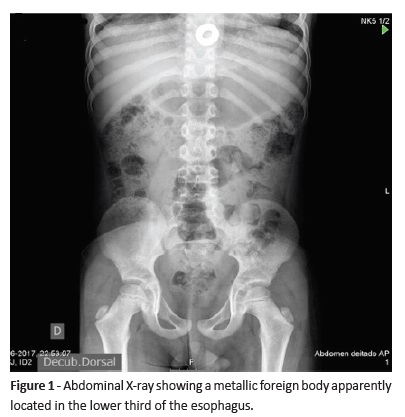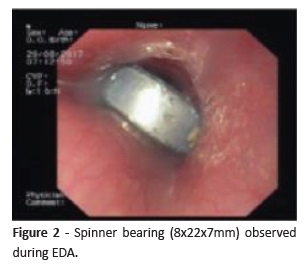Serviços Personalizados
Journal
Artigo
Indicadores
-
 Citado por SciELO
Citado por SciELO -
 Acessos
Acessos
Links relacionados
-
 Similares em
SciELO
Similares em
SciELO
Compartilhar
Nascer e Crescer
versão impressa ISSN 0872-0754versão On-line ISSN 2183-9417
Nascer e Crescer vol.28 no.1 Porto mar. 2019
https://doi.org/10.25753/BirthGrowthMJ.v28.i1.14296
CASE REPORTS | CASOS CLÍNICOS
Fidget spinners: most popular children’s toys, same dangers as in the past…
Fidget spinners: a moda do momento perigos à antiga…
Tatiana PereiraI, Ana Reis MeloI, Mónica CosteiraI, Isabel Pinto PaisI, Maria de Céu EspinheiraI, Eunice TrindadeI, Jorge Amil DiasI
I Pediatric Gastroenterology Unit, Pediatrics Department, Centro Materno Pediátrico, Centro Hospitalar Universitário de São João. 4200-319 Porto, Portugal. taty.pereira.0@gmail.com; anareismelo@gmail.com; monicasnacosteira@gmail.com; isapintopais@gmail.com; ceuespinheira@gmail.com; eunice_trindade@netcabo.pt, jorge.amil@outlook.pt
Endereço para correspondência | Dirección para correspondencia | Correspondence
ABSTRACT
Introduction: Fidget spinners are small rotating toys with a central disc and three tips. They are currently one of the most popular children’s toys.
Case report: The case of a seven-year-old child admitted to the Emergency Department of the local hospital due to epigastric pain following ingestion of a fidget spinner component is described. Due to presence of a foreign body in the digestive tract, an upper digestive endoscopy (EDA) was performed, and the foreign body identified in the distal esophagus was removed without complications.
Discussion/Conclusion: Although these are adequately sized toys, fidget spinners can easily be dismantled by children, allowing easy access to its components. Some units have LED lights with lithium batteries and esophageal ulcers have been described only a few hours after their ingestion. With this report, the authors aim to advise Pediatricians to actively alert parents to the potential risks of a seemingly innocent toy, based on a real case.
Keywords: choking; fidget spinners; foreign body
RESUMO
Introdução: Os fidget spinners constituem um pequeno brinquedo giratório com um disco central e três pontas. Neste momento, são um dos brinquedos mais populares entre as crianças.
Caso clínico: É descrito o caso de uma criança de sete anos que recorreu ao Serviço de Urgência do hospital da área de residência por dor epigástrica e ingestão de uma peça constituinte de fidget spinner. Devido à presença de corpo estranho no tubo digestivo, foi realizada endoscopia digestiva alta (EDA), sendo removido o corpo estranho identificado no esófago distal, sem intercorrências.
Discussão: Apesar de serem brinquedos de dimensões adequadas, os fidget spinners são facilmente desmontados pelas crianças, permitindo um fácil acesso aos seus constituintes. Alguns exemplares possuem luzes LED com baterias de lítio, estando descritas úlceras esofágicas poucas horas após a ingestão das mesmas. O presente caso clínico visa alertar os Pediatras para a necessidade de informar os pais para os riscos potenciais de um brinquedo aparentemente inócuo, a partir da descrição de um caso real.
Palavras-chave: corpo estranho; engasgamento; fidget spinner
Introduction
Fidget spinners are small rotating toys with a central disc and three tips which, when rotated, create a rapid rotation with a dynamic visual effect.1 They were created in the 90s by the American Catherine Hettinger, destined for children with Autism Spectrum Disorder or Hyperactivity Disorder and Attention Deficit Disorder.2 Presently, they are one of the most popular children’s toys.3 A new variation of this design includes a light-emitting diode (LED) housed within the surrounding pods, each with a dedicated button battery.4 Scattered reports exist of children ingesting parts of these fidget spinners, but to the authors’ knowledge this is the first report in Portugal. Based on this real case, Pediatricians are advised to actively alert parents to the potential risks of a seemingly innocent toy.
Case report
A seven-year-old boy without relevant medical history was admitted to the Emergency Department of the local hospital due to epigastric pain after ingestion of part of a fidget spinner. He denied other accompanying symptoms, such as dysphagia, vomiting, sialorrhea, difficulty breathing, coughing, or stridor. The child presented no additional alterations on physical examination.
A plain X-ray revealed a metallic foreign body located in the lower third of the esophagus (Figure 1). An upper digestive endoscopy (EDA) was performed. The foreign body (spinner bearing), identified in the distal esophagus, was mobilized into the gastric cavity and removed with a basket, without endoscopic lesions or other complications (Figure 2).
Discussion
Although fidget spinners are adequately sized toys, they can easily be dismantled by children, allowing easy access to their bearings.5 Consequently, situations similar to the present clinical case can easily happen. Toy variants exist on the market that do not have any type of warning or CE marking (mandatory for a toy to be sold in the European market). Approximately 16.000 copies were recently seized by the Food and Economic Security Authority (ASAE).6
Fidget spinners have been marketed as concentration aids for children with anxiety, attention-deficit/hyperactivity, or autism spectrum disorders. Their alleged benefits remain scientifically unfounded and the toys have even been banned in several educational settings.2
There are numerous reports of accidental ingestion of these toys causing severe esophageal injury. They include a four-year-old female who swallowed a plastic disc that dislodged from a fidget spinner toy, vomiting en route approximately three hours after initial ingestion and expelling the object. Twelve hours post-ingestion, the girl underwent an upper endoscopy, which identified two deep ulcerations with black eschar formation in the mid esophagus. In another reported case, a three-year-old boy swallowed an unspecified part of a fidget spinner and was subjected to endoscopic removal seven hours after estimated time of ingestion, with moderate to severe esophagitis described. Both cases illustrate how quickly and significantly esophageal and adjacent mediastinal structures’ injury can occur.7,8 These toys are usually made of two parts: a central bearing that is gripped with index finger and thumb and a three-pronged rotational blade. A new variation of this design includes a light-emitting diode housed within the surrounding pods, each with a dedicated button battery. Cases of esophageal ulcers a few hours after ingestion of these batteries have been reported. In the case of an untested version, ingestion of electrical components may require immediate removal due to potentially dramatic repercussions.4,9 A recent series of articles published in the Journal of Pediatric Gastroenterology and Nutrition describes cases of button battery ingestion, in which the button battery was hidden inside a fidget spinner that was broken open by a child, and the battery swallowed.7,8,10 An editorial comment even suggests that it may be time to push the “panic button” in view of the potentially severe complications.11 With this report, the authors emphasize the importance of closely watching a child playing with a fidget spinner, regardless of age. These may not be harmless toys, and Pediatricians should make recommendations for inspection of the chosen model, with an emphasis on safety and potential risk of suffocation, swallowing, and choking. Based on this and other reports, Pediatricians should alert parents to the potential risks of this seemingly innocent toy.
REFERENCES
1. Jornal Expresso [online]. Conheça o Fidget Spinner, o brinquedo anti-stress que já foi proibido em algumas escolas. May, 2017. (Accessed 8 Nov 2017). Available at: http://visao.sapo.pt/actualidade/sociedade/2017-05-10-Conheca-o-Fidget-Spinner-o-brinquedo-anti-stress-que-ja-foi-proibido-em-algumas-escolas . [ Links ]
2. Schecter RA, Shah J, Fruitman K, Milanaik RL. Fidget spinners Purported benefits, adverse effects and accepted alternatives. Curr Opin Pediatr. 2017; 29:616-8. DOI: 10.1097/MOP.0000000000000523 . [ Links ]
3. Fidget Spinners: A Pediatrician’s Take - Medscape - Jun 05, 2017.
4. Koo J, Tamura D. Fidget Spinner Battery-LED Unit Ingestion in a 13-Month-Old Boy. 2017. Clinical Pediatrics, p.000992281773330. [ Links ]
5. NiT[online] Tudo o que precisa de saber sobre os perigos dos Fidget Spinners. [Accessed 8 Nov 2017] Available at: https://nit.pt/out-of-town/miudos/perigos-dos-fidget-spinners. [ Links ]
6. Jornal Expresso [online]. ASAE apreende 16.000 brinquedos “spinners” por falta de requisitos de segurança. [Accessed 8 Nov. 2017] Available at: http://expresso.sapo.pt/sociedade/2017-06-03-ASAE-apreende-16.000-brinquedos-spinners-por-falta-de-requisitos-de-seguranca.
7. Khalaf RT, Gurevich Y, Marwan AI, Miller AL, Kramer RE, Sahn B. Button Battery Powered Fidget Spinners: A Potentially Deadly New Ingestion Hazard for Children Journal of Pediatric Gastroenterology and Nutrition. 2018; 66:595-7. [ Links ]
8. Bousvaros A, Rufo P. Commentary Button Batteries in Fidget Spinners: Is It Time to Push the “Panic Button’’?, 2018 Journal of Pediatric Gastroenterology and Nutrition. 2018; 66:557-8.
9. Rosenfield D, Strickland M, Hepburn C. After the Recall: Reexamining Multiple Magnet Ingestion at a Large Pediatric Hospital. The Journal of Pediatrics. 2017; 186:78-81. [ Links ]
10. McClain A, Jackson WD, Robson J. Fidget Spinners Can Be a Pain in the Neck, Journal of Pediatric Gastroenterology and Nutrition. 2018; 66:e110. [ Links ]
11. Tipnis NA, Thomas C. Fidget Spinner Ingestion, Journal of Pediatric Gastroenterology and Nutrition. 2018; 66:e111-2. [ Links ]
Endereço para correspondência | Dirección para correspondencia | Correspondence
Tatiana Pereira
Pediatric Gastroenterology Unit
Pediatrics Department
Centro Materno Pediátrico
Centro Hospitalar Universitário de São João
Alameda Prof. Hernâni Monteiro
4200-319 Porto
Email: taty.pereira.0@gmail.com
Received for publication: 07.05.2018
Accepted in revised form: 18.12.2018
















